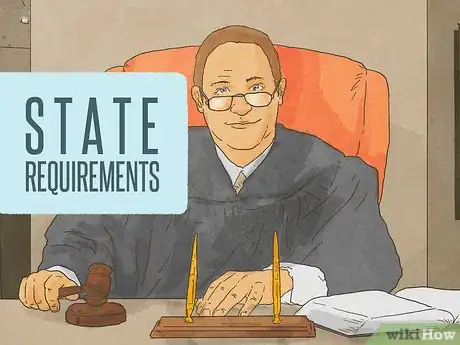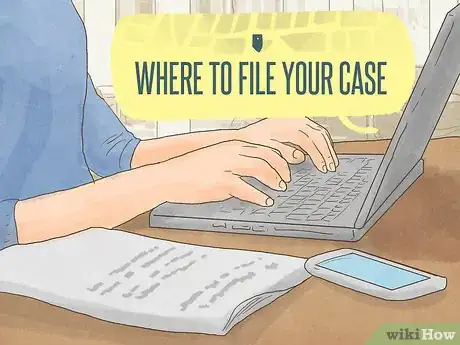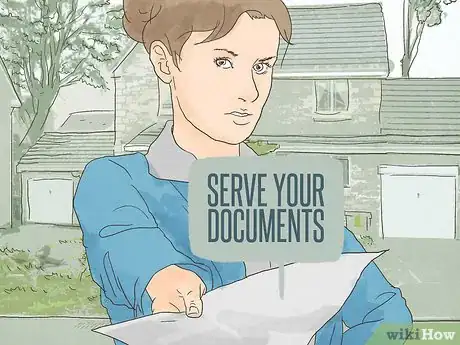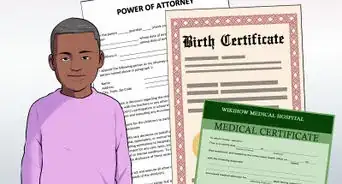This article was written by Jennifer Mueller, JD. Jennifer Mueller is an in-house legal expert at wikiHow. Jennifer reviews, fact-checks, and evaluates wikiHow's legal content to ensure thoroughness and accuracy. She received her JD from Indiana University Maurer School of Law in 2006.
There are 9 references cited in this article, which can be found at the bottom of the page.
This article has been viewed 20,230 times.
When you are no longer in a relationship with the other parent of your child, you may need the court's help to make suitable arrangements regarding where the child will live and who will make decisions on her behalf. If you plan to file a lawsuit in court for an initial custody order or a modification to an existing order, there are certain actions you can take that may increase your odds of receiving a favorable ruling at trial. However, there's no real formula that's guaranteed in all cases, so you must take your individual circumstances and needs into account.
Steps
Researching Your Case
-
1Consider hiring an attorney. Family law is detailed and far reaching, and judges have great latitude for discretion. If you file on your own, keep in mind you'll be expected to understand the law and know the procedural rules as well as any attorney.
-
2Understand the different types of child custody. You need to know the difference between types of custody so you know what arrangement to ask the court for.
- If you have physical custody of the child, that means the child lives with you most of the time, or even all of the time.
- If you have legal custody, that means you have the right to make decisions about the child's life, such as where the child will go to school or if the child will go to church.[1]
- Courts award joint custody or sole custody. Sole custody means you are the only parent with that type of custody, while joint custody means both parents share it. For example, you may have joint physical custody and sole legal custody.[2]
Advertisement -
3Learn your state's requirements for filing a custody case. These requirements will differ depending on whether you are filing for an initial order or for modification of an existing order.
- An initial request for a custody determination typically is made alongside a divorce case, but they may also be filed during a case to settle paternity, if the parents were never married. In some states that recognize legal separation, you may request a court custody order when you file for legal separation.[3]
- For modification of an existing order, generally you must show that there has been a significant change in circumstances since the court made its original ruling. These changed circumstances must have such a profound effect on the child that a custody modification is essential to the child's welfare.
-
4Decide specifically what you want out of the case. You need to know precise details of the arrangement you want, especially if you're asking for changes to an existing order. A broad request such as "I want custody" likely will be insufficient.
- Divide a sheet of paper into three columns, and write down each thing you want separately in the first column. For example, if you want to make all schooling decisions for your child, that would be one item on your list. If you also wanted to have your child with you every Christmas, that would be another item.
- As you conduct your research, use the second column to write down what you must prove to get the thing you want. Use the third column to list evidence you can gather to prove all of that.
- For example, suppose you want to make all your child's schooling decisions, and your state prefers both parents make these decisions equally unless it would endanger your child. In the second column, you would have to prove that allowing the other parent to assist in schooling decisions would endanger your child. If the other parent refused to let your child participate in special needs programs despite the fact that your child was diagnosed with a learning disability, this would be evidence that might prove that allowing the other parent to help make schooling decisions would be a danger to your child.
-
5Understand your state's standards and presumptions. All states determine child custody based on the best interests of the child, although the factors analyzed in making this decision vary among states and on a case-by-case basis.
- Factors evaluated by courts in determining the child's best interests include where the parents want the child to live, where the child wants to live, how the child gets along with the parents, siblings, or anyone else in the home, the child's adjustment to her school and community, and any evidence of abuse or neglect.[4]
- The law presumes certain custody arrangements to be in the child's best interests. If you want the court to reach a different result, you must overcome that presumption by proving that following it would endanger the child's health and welfare.
- For example, many states presume it is in the best interest of the child if both parents share decision-making power and residential time. To overcome such a presumption, you must demonstrate that allowing the other parent to make decisions or spend significant time alone with the child would endanger the child.
- If there are factors weighing against this in your case, you must emphasize those. For example, if your child's other parent is an alcoholic and frequently is neglectful, that could weigh against that parent having equal time with the child.[5]
-
6Read applicable case law. Judges not only look to statutes to rule on a case, they also consider case law – decisions already made by higher courts such as the state supreme court in similar cases.
- You may be able to find a searchable database online at the website of your state's highest court. If one is not available, you also can find case law resources at the law library in your local courthouse.[6]
- As you read cases, write down any cases that are similar to yours. If a case supports what you want, make a note of it. If a case goes against what you want, figure out how to distinguish the case from your own – in other words, be prepared to explain to the judge how your case is different from the one that's already been decided and was contrary to your position.
Preparing Your Case
-
1Make a list of your strengths and weaknesses. Nobody's perfect, and your judge will know that. Rather than trying to present yourself as a superhero or a knight in shining armor, acknowledging and accepting that you aren't as effective in some areas will go a long way.
- You don't necessarily have to include these things in your paperwork to the court, but assessing yourself objectively can help you have a more balanced approach.[7]
-
2Make a list of the other parent's strengths and weaknesses. Try to avoid being too critical, because the judge will be able to tell when you're being biased for reasons that have nothing to do with the child's best interests.
- It's all too easy to focus on the other parent's faults, because you wouldn't be filing for custody if you thought he was a great parent. But keep in mind that he also loves the child, and if there are things he can do well, those are areas where you can compromise and give him a larger role in the child's life.[8]
-
3Find out where you need to file your case. If you're asking for a modification, the court that issued the original order most likely is the court that will hear the request for modification. If you are seeking a divorce and custody order, the correct court most likely will be in the county where you or your spouse live.
- If the child has moved to another state with the approval of the court, the court where the child has lived for at least six months may be the appropriate court. In this situation, it would be advisable to consult an attorney.
-
4Go to the court and observe the judge. Once you know the judge who will be hearing your case, spend some time sitting in that judge's courtroom gallery while court is in session.
- In smaller counties, there may be only one judge who hears family law cases, so you would know immediately who would be hearing your case. In larger courts, you won't be assigned a judge until you file your documents.
- Once you know who your judge will be, go online or to the clerk's office and get the court's calendar. Most domestic relations and custody hearings are open to the public. Look for motion days, because there will be a lot of people in the courtroom on those days.
- Sitting in court allows you to get a feel for the type of issues that tend to come up during a custody case, and how your judge handles those issues. Make a note of how your judge interacts with people who don't have attorneys, including whether she seems to be harder on them or whether she is more understanding and helps them navigate the system.
-
5Revise your lists based on your observations. After you've seen your judge in action, you can revise your list of what you want out of your custody case to accommodate the judge's preferences.
-
6Gather evidence to support your argument. You can't win a custody case simply by telling the judge that you'd be a better parent – you must make factual statements and be able to back them up with concrete evidence.
- Talk to an attorney if you're unsure about the legality of your methods for gathering evidence. For example, in some states it's perfectly legal to record your own phone conversations with anyone without telling them they're being recorded, but in other states it may not be.
- In some situations you may have to file your case before you can get the evidence you need. Once you've filed a case, you can request certain documents or information from the other side, interview the other party under oath, and inspect relevant property or other items, and the other side generally must comply with your requests.
- Make estimated budgets and calculate your income to show how you could provide for the child. If you have additional resources that would be available only if you had custody of the child, you should include those as well.[9] For example, perhaps if your child is living with you, his grandparents will be able to pick him up from school, saving you the cost of after-school care.
-
7Decide if you can get together with the other parent and work out a temporary or even permanent arrangement on your own without filing a case in court. If you and the other parent have relatively amicable relations, you may be able to come to your own agreement with the help of a neutral third party such as a certified mediator.[10]
Filing Your Case
-
1Fill out forms or draft the necessary documents. If you are filing for an initial custody order, you will need to file a petition and open a new case.[11] For modification of an existing order, on the other hand, you typically would file a motion in the same court that issued the original order.[12]
- Most states have forms available online and in the clerk's office of your local court. If you have trouble completing them, you can talk to someone in your nearest legal self-help center and they will walk you through the process.
-
2Sign in front of a notary, if necessary. If any of your documents include a notary block, you must wait until you're in the presence of a notary so she can witness you signing those documents. The courthouse usually has notary services available, although you may be charged a small fee.
-
3Assemble your signed documents together with all exhibits and make copies. You'll need to make at least three copies of your packet of paperwork before filing. Review the instructions that came with your forms or talk to someone in the clerk's office to verify exactly how many copies you'll need.
-
4File your documents with the clerk of court. When you take your paperwork to the clerk's office and pay the filing fee, the clerk will stamp your originals and copies "filed" and give you back the copies. At least one of these copies will be for your records; the other you'll need to send to the other parent.
- The fees you're charged will vary depending on the court where you file and whether you're filing for an initial order or modification of an existing order. However, you generally can expect to pay less than $200.[13] If you can't afford the filing fees, the court will have a form you can fill out to apply for a waiver.[14]
- The clerk will file your originals with the appropriate court, and schedule a date for your next appearance. In many states, you must complete court-ordered mediation before your case will be heard by a judge.[15]
-
5Serve your documents on the other parent. Once you've filed for custody, you'll have to send the paperwork to the other parent or current guardian so they know about your lawsuit and have an opportunity to respond.
- Find out if you can serve using certified mail or if the court requires personal service. If personal service is required, you can contact the state marshal's office or the sheriff's department, or hire a private process serving company to complete service for you. The clerk's office should have a list of acceptable process servers.[16]
-
6Continue building your case. Now that you've filed your lawsuit, you can use discovery tools such as interrogatories, requests for production and depositions to get additional information from the other parent to use as evidence in your case.
References
- ↑ http://www.nolo.com/legal-encyclopedia/child-custody-faq-29054-8.html
- ↑ http://www.nolo.com/legal-encyclopedia/child-custody-faq-29054-8.html
- ↑ https://www.utcourts.gov/howto/divorce/custody.html
- ↑ http://www.kslegislature.org/li_2012/b2011_12/statute/023_000_0000_chapter/023_032_0000_article/023_032_0003_section/023_032_0003_k/
- ↑ http://www.statutes.legis.state.tx.us/Docs/FA/htm/FA.153.htm
- ↑ http://www.tsc.state.tn.us/courts/supreme-court/opinions
- ↑ http://www.divorcenet.com/states/nationwide/checklist
- ↑ http://www.divorcenet.com/states/nationwide/checklist
- ↑ http://www.divorcenet.com/states/nationwide/checklist
- ↑ http://www.nolo.com/legal-encyclopedia/child-custody-faq-29054-8.html
- ↑ http://www.jud.ct.gov/forms/grouped/family/custody.htm
- ↑ https://www.courts.mo.gov/page.jsp?id=38335
- ↑ https://www.clerkofcourt.maricopa.gov/services/filings/filing-fees
- ↑ http://www.jud.ct.gov/forms/grouped/family/custody.htm
- ↑ https://www.courts.mo.gov/page.jsp?id=38335
- ↑ http://www.jud.ct.gov/forms/grouped/family/custody.htm













































































